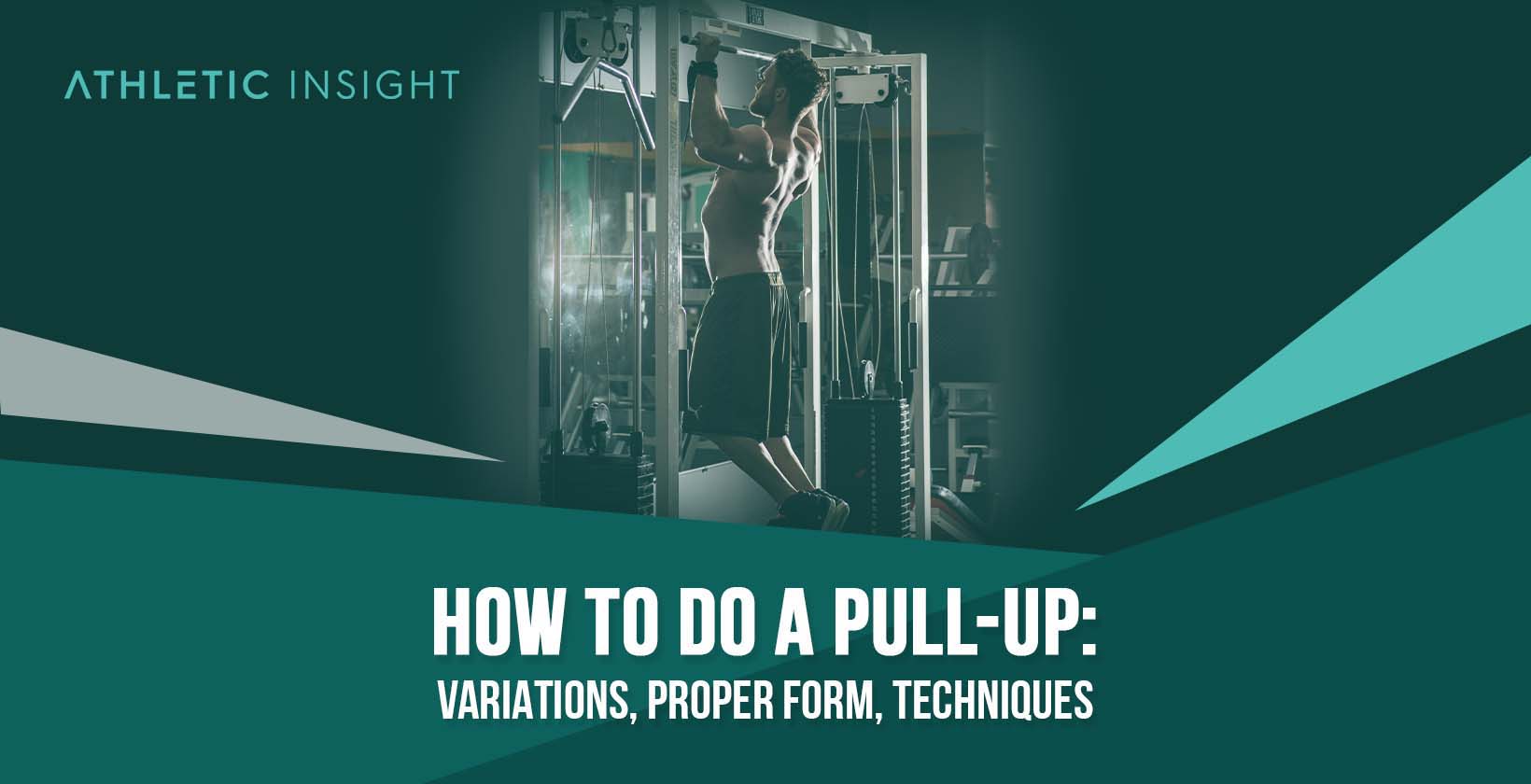The pull-up is one of the most effective and accessible back exercises one can incorporate into a workout routine. The pull-up is a bodyweight exercise that involves pulling up one’s body against gravity, typically gripping a horizontal bar, utilizing several muscle groups in the arms, back, and core region.
You should include pull-ups in your routine for several reasons. Besides the obvious benefits of strength and hypertrophy (growth) training for the muscles involved, the compound nature of pull-ups lends itself to hormonal advantages and Central Nervous System (CNS) development and promotes healthy posture.
The pull-up involves several different muscle groups. The biggest players in this movement are the latissimus dorsi, the posterior (rear) head of the deltoid, biceps, and scapular muscles. However, both the major and minor rhomboids, forearms, trapezius, and abdominal muscles are involved, as well. Pull-ups are a great way to enhance grip strength and improve the appearance of many mirror muscles (essentially the muscles that you most commonly notice in the mirror).
Pull-ups are typically performed on a horizontal bar above the level of your head. You grip the bar with both hands, arms fully extended, and body suspended. Then, you flex your arms so that the body is pulled upwards until your chin is above the bar. The body is then lowered until the arms are fully extended again.
There are many types of pull-ups. Just with grip and grip width variation, you can perform pull-ups in several different ways. There are also weighted pull-ups, one-arm pull-ups, archer pull-ups, kipping pull-ups, muscle-ups, and many more. The variation most commonly used are classic pull-ups with palms facing away and grip at shoulder width. The pull-up is a great addition to other compound lifts you may utilize for your back.
Pull-ups can be an intimidating movement. The reason is mostly that there is a lot of misinformation out there. A proper pull-up can and should be utilized by most fitness enthusiasts, whether they are beginners or veterans.
The biggest and most common mistakes you will find with the pull-up technique are related to form. Most pull-ups you will have the unfortunate privilege of witnessing are not performed with full Range of Motion (ROM), typically meaning partial instead of full extension of the arms is performed at the beginning and end of the movement.
Many also perform pull-ups with excessive speed and momentum. They take away from much of the work that needs to be on the primary movers, stabilizers, and core. This habit is also potentially dangerous. Especially for beginners, such unstable and uncontrolled movements can unnecessarily strain muscles and cause injury or lead to accidents from losing grip on the bar. Partial ROM also has negative long-term consequences from incomplete muscle development and adversely impacts mobility.
How To Perform Pull-up With Proper Form?
Proper form for pull-ups is vital. Pull-ups should start with arms fully extended, and the core fully engaged, and end with arms fully flexed and core engagement maintained. Here is a step-by-step guide to proper pull-up form.
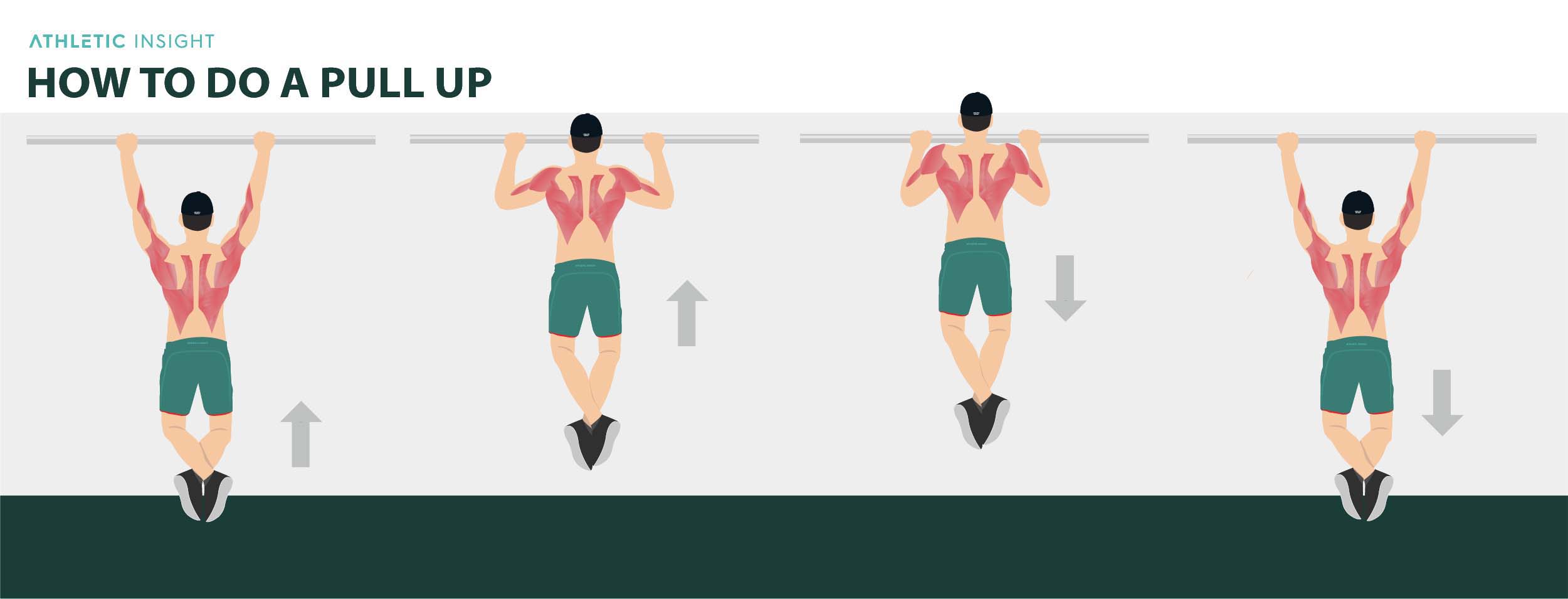
- Grip the bar at shoulder-width with palms facing away from yourself
- Extend your arms as much as possible
- Stabilize your core and maintain a neutral spine and pull up
- Move upwards until your chin is above the bar
- Move back downwards until your arms are again fully extended
What Are the Phases of Conventional Pull-up?
A conventional pull-up requires a forward-facing grip at shoulder width. The arms will start and end with full extension, with full flexion at the top of the movement. There are different phases to learning a conventional pull-up. Without properly moving through these phases, you are likely to develop habits and imbalances that will hurt your long-term progress.

1. Teach Your Muscles How to Pull Up
Many tend to think about the physiological aspects of an exercise but not the aspects relating to the nervous system. Any exercise, especially those that utilize free weights and calisthenics, needs to be learned like any other movement. In the same way that babies need to learn how to crawl and walk before running, our bodies need to understand the pull-up gradually.
The worst mistake you can make is rushing progress and bypassing essential steps. It is better to perform one rep with perfect form than to churn out multiple ego reps with terrible form, which, unfortunately, you will see in most public gyms.
2. Train the Body for Bodyweight Training
Bodyweight training, or calisthenics, is unique in that you utilize your own body weight as the exercise load. Especially for those starting out on their fitness journey, this load can exceed what you will be able to handle with proper form. For this reason, you need to train your body with movements that will change the leverage utilized by the moving joints, which we will expound upon later.
Movements similar to pull-ups can be utilized, as well, such as cable lat-pulldowns, assisted pull-ups, or negative pull-ups. Mobility, particularly thoracic (upper spine) mobility, needs to be developed or at least maintained. As was mentioned above, attempting to just jump into performing pull-ups with no training will lead to injury and long-term deterrents.
3. Build Your Strength to Perform the Pull-Up
Performing pull-ups with proper form and a full range of motion requires a considerable amount of strength. The best way to train for a specific movement is to practice that movement. Of course, this doesn’t necessarily mean attempting to perform the movement haphazardly.
It does mean, however, emulating the movement to the closest extent possible. For pull-ups, this will involve negative pull-ups, assisted pull-ups with bands, bodyweight bar rows, and others. This will allow you to develop the strength necessary for the movement and the coordination required for proper execution.
What Are the Mistakes for Pull-up Form?
The pull-up is a fairly straightforward movement. However, this does not mean a good pull-up form is easy to achieve.
By far, the primary culprit when it comes to bad pull-up form is partial ROM. Most people attempting to perform pull-ups, even among experienced athletes, do so without full extension or flexion of the elbow joint. Typically, this happens because the pull-up becomes exponentially more difficult when the arms are allowed to reach full extension and flexion, thereby reducing the number of reps one can achieve.
However, allowing your ego to influence your form in this way is harmful to real progress. Not only are you cheating your primary working muscles (most notably the latissimus dorsi, scapular muscles, and biceps muscles) of potential strength and hypertrophy gains, the incomplete range of motion will negatively affect your elbow and thoracic mobility.
The other pull-up mistake often seen with conventional pull-up form is the lack of core stability. Instead of maintaining a neutral spine, many will allow their torso and lower body to flail in an attempt to perform the movement. This is likely due to the lack of strength necessary to perform the pull-up properly.
Failure to remedy this poor form will severely reduce ideal core engagement and can result in muscular development imbalances. Moreover, if this movement is performed on a doorway suspended pull-up bar with such flailing motions, the danger of falling is present.
How To Determine Proper Weight for Pull-Up?
To determine the proper weight for a pull-up, one should be able to perform 3 sets of 8-10 pull-ups with perfect form. At this point, you can add weight gradually, ideally in increments of 5-10 pounds at a time. Once you add weight, you should be able to perform 3 sets of at least 5-7 repetitions with the added weight while maintaining perfect form, at which point you can add more weight.
What Is the Importance of Grip for Pull-up?
Grip and grip strength are important for performing a pull-up because grip provides the ability to perform more reps and better form for back muscle activation. Grip strength means that the weightlifter will be able to hold the weight with a better grasp while performing the weightlifting movement. The connection between the grip and the pull-up involves the pull-up’s “Weight Increasing” phase.
During the pull-up movement, a strong grip will help the bodybuilder or the person who performs the pull-up, with a better muscle concentration. Grip strength strongly influences pull-up performance and is further improved by performing pull-ups. For some beginners, lack of grip strength may be the biggest hurdle to achieving the pull-up movement. For those who are able to perform pull-ups, this exercise is very effective for increasing practical grip strength.
Changing how you grip the bar is also an effective way to vary the stimuli your body receives. For instance, simply changing the direction that your palms face when gripping the bar can reduce the load on certain muscles and increase the load for others. In some cases, changing your grip can affect entirely different muscles, although the primary movers for all pull-up variations will remain largely the same.
Which Muscles Are Involved While Performing Pull-up?
The primary muscles engaged when performing pull-ups are the latissimus dorsi, scapular muscles, biceps muscles, and the posterior head of the deltoids.
The major and minor rhomboids, trapezius, forearms, and muscles in the abdomen also play a very important role, with the pectoralis major and deltoid anterior head playing a minor role in internal rotation.
How is each muscle affected by pull-ups? Let’s take a look.
- Latissiumus dorsi – the latissimus dorsi is responsible for the extension of the shoulder joint (from resting position to reaching behind the body). Pull-ups will strengthen this motion and contribute to the coveted v back shape.
- The scapular muscles (teres major and minor, infraspinatus, subscapularis, and supraspinatus) are responsible for shoulder joint rotation and stabilization. Pull-ups primarily utilize internal rotation, which is accommodated by the subscapularis and teres major muscles, and are conducive to increasing internal rotation strength and stability. This is very important for counteracting imbalances that may be present from an overemphasis on push exercises that utilize external rotation.
- Biceps are responsible for elbow joint flexion (wrist joint draws closer to shoulder joint). Pull-ups will enhance strength and mobility in this plane of motion, primarily if performed correctly with full ROM. In terms of aesthetics, while there are exercises that will target the biceps more directly, pull-ups are more than sufficient to stimulate this muscle group’s growth.
- The posterior head of the deltoid muscle, like the latissimus dorsi, extends the shoulder joint, which means it plays a role in all pulling exercises. It is crucial for internal rotation of the shoulder joint, as well. The deltoid has three heads, and pulling exercises like pull-ups are essential for developing well-rounded shoulders, both with regard to function and aesthetics.
- Rhomboids are responsible for scapular retraction. A full ROM pull-up will integrate scapular retraction for maximal effect. Training the rhomboids is essential for thoracic health and mobility and good posture. Aesthetically, you cannot neglect the rhomboids if you desire a back that looks sinewed and full.
- The trapezius muscle is responsible for scapular elevation (imagine pulling your shoulders up towards your ears). While it does not play as central a role in the pull-up as some of the other back muscles, a full ROM pull-up will have trapezius involvement. No athlete concerned with aesthetics should neglect trapezius training.
- The forearm contains a number of muscles responsible for rotation and flexion of the wrist joint, as well as flexion of the elbow joint. These muscles largely determine grip strength and efficiency of elbow flexion. In addition, forearm size contributes greatly to the aesthetic appeal of the arms.
- The 5 abdominal muscles – the external and internal obliques, pyramidalis, rectus abdominis, and transversus abdominis – are largely responsible for maintaining posture and supporting your body through various movements, including pull-ups. The lack of motion in the torso that is apparent in a pull-up performed with good form may betray minimal involvement of the muscles in the abdomen. In fact, this is evidence of their vital role, as there should be minimal motion in every joint outside of the elbow and shoulder joints. In terms of aesthetics, little needs to be said about the importance of this muscle group.
- The pectoralis major is responsible for flexion (from resting position, moving towards the front of the body) and internal rotation of the shoulder joint. This muscle’s role in pull-ups is smaller, but the pectoralis major deserves mention due to the internal shoulder joint rotation involved in the pull-up movement. While the pull-up will provide a stimulus for the pectoralis major, other exercises, like the push-up and bench press, should be implemented for more significant hypertrophy and strength gains.
- The anterior head of the deltoid plays a similar role to the pectoralis major. Like the pectoralis major, this muscle plays a smaller role in the pull-up exercise but deserves mention as a mover in internal shoulder rotation. Handstand presses or shoulder presses should be utilized for stimulating the growth of this muscle in addition to pull-ups.
How To Do A Pull-Up?
Here’s a step-by-step guide to dominate the Pull-Up.
- Grip the bar at shoulder-width with palms facing away from yourself
- Extend your arms as much as possible
- Stabilize your core and maintain a neutral spine and pull up
- Move upwards until your chin is above the bar
- Move back downwards until your arms are again fully extended
1. Grab the bar with your palms facing away from you at shoulder width
This is the standard grip setup used for conventional pull-ups. It is ideal for maximum engagement of the latissimus dorsi and rhomboid muscles.
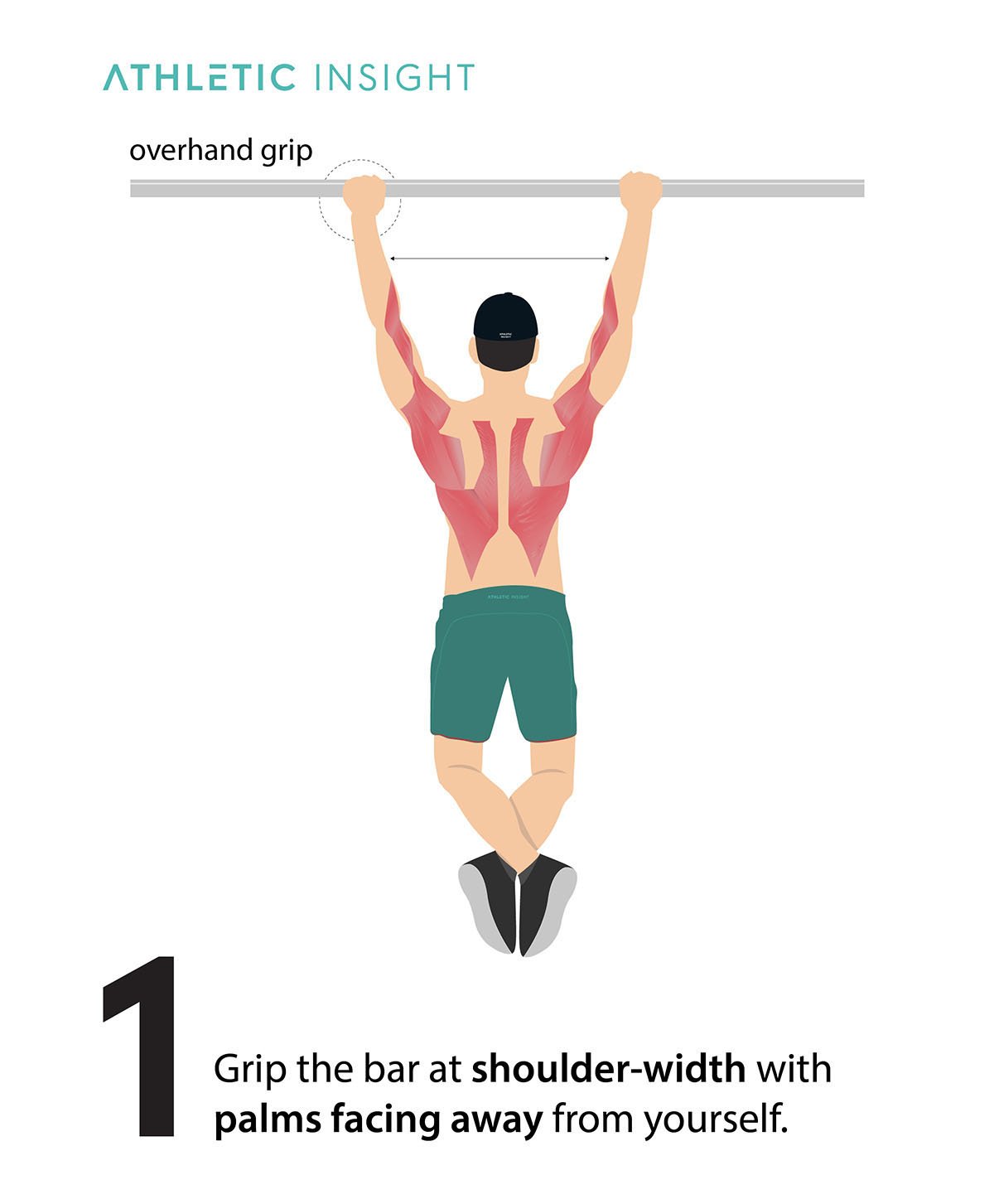
2. Extend your arms as far as possible
This step is crucial for the proper development of the muscles involved in a pull-up. Failure to allow full extension of the arms will produce poor results and will negatively impact mobility long-term. You want perfect full ROM to dominate pull-up form.
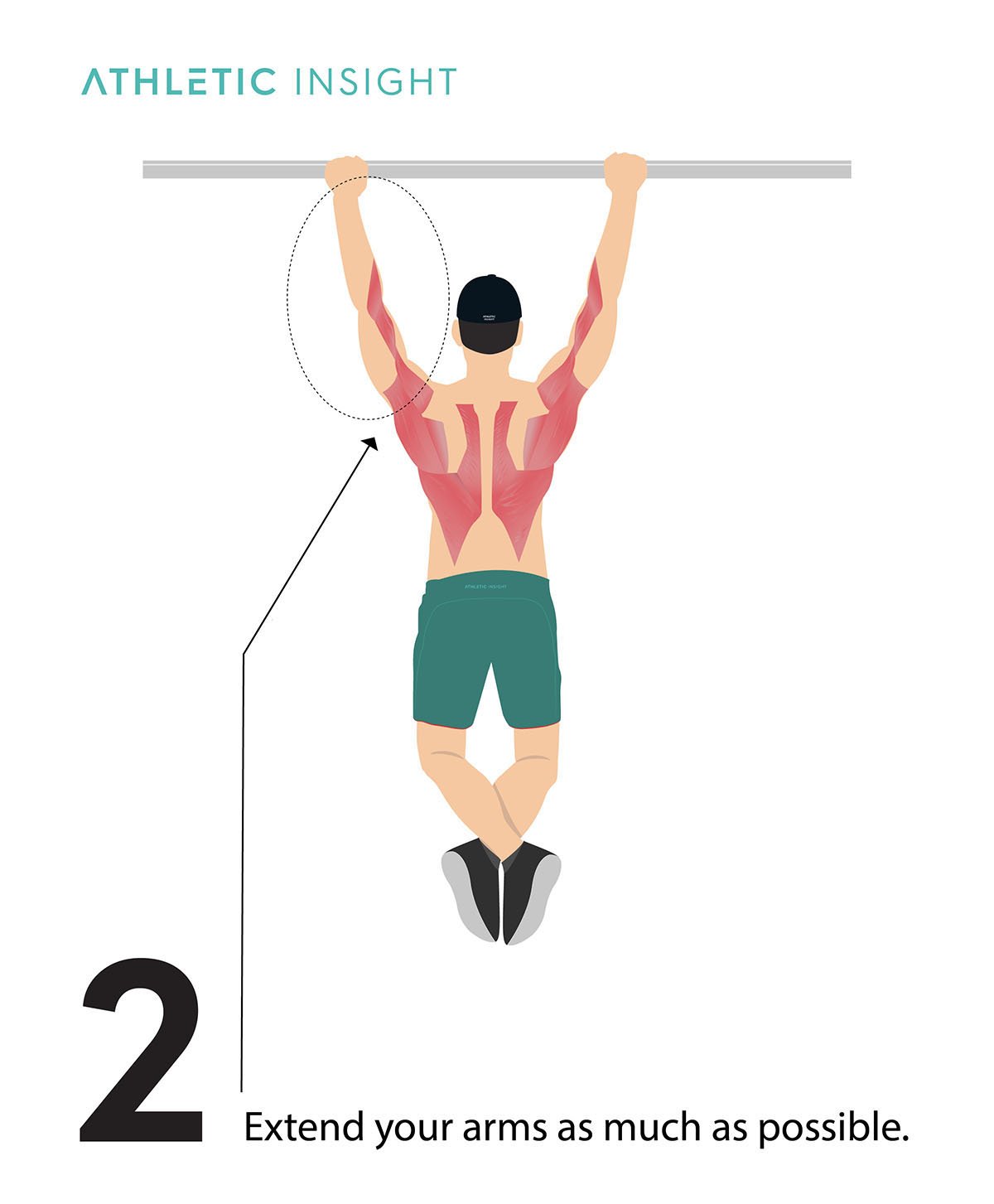
3. Maintain a neutral spine and strong core before pulling up
Another vital aspect of the pull-up, tightening the muscles in the abdomen and stabilizing your torso, will allow maximum and balanced stimulus of the intended muscle groups and ensure your safety.
While pulling up, it is imperative that you maintain proper form. The only joints in motion should be your shoulder and elbow joints. There should be little to no movement from the spine, hip joint, or knee joint.
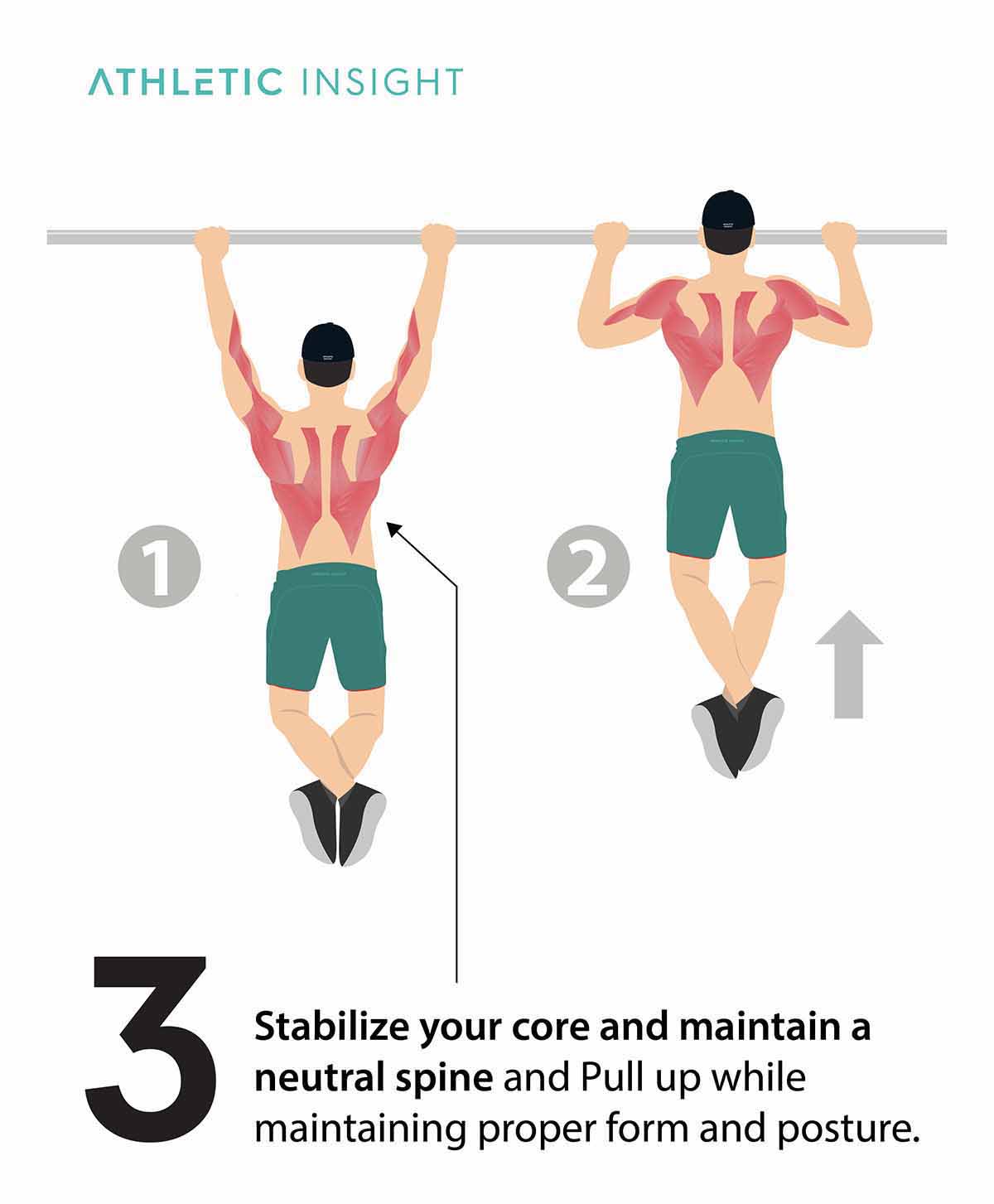
4. Move upwards until your chin is above the bar
At the top of the pull-up motion, your elbow joint should be in full flexion. This is as vital as ensuring the full extension of the arms at the bottom of the pull-up. Following this step will ensure proper development of the muscles proper development and prepare your body for more advanced pulling exercises.
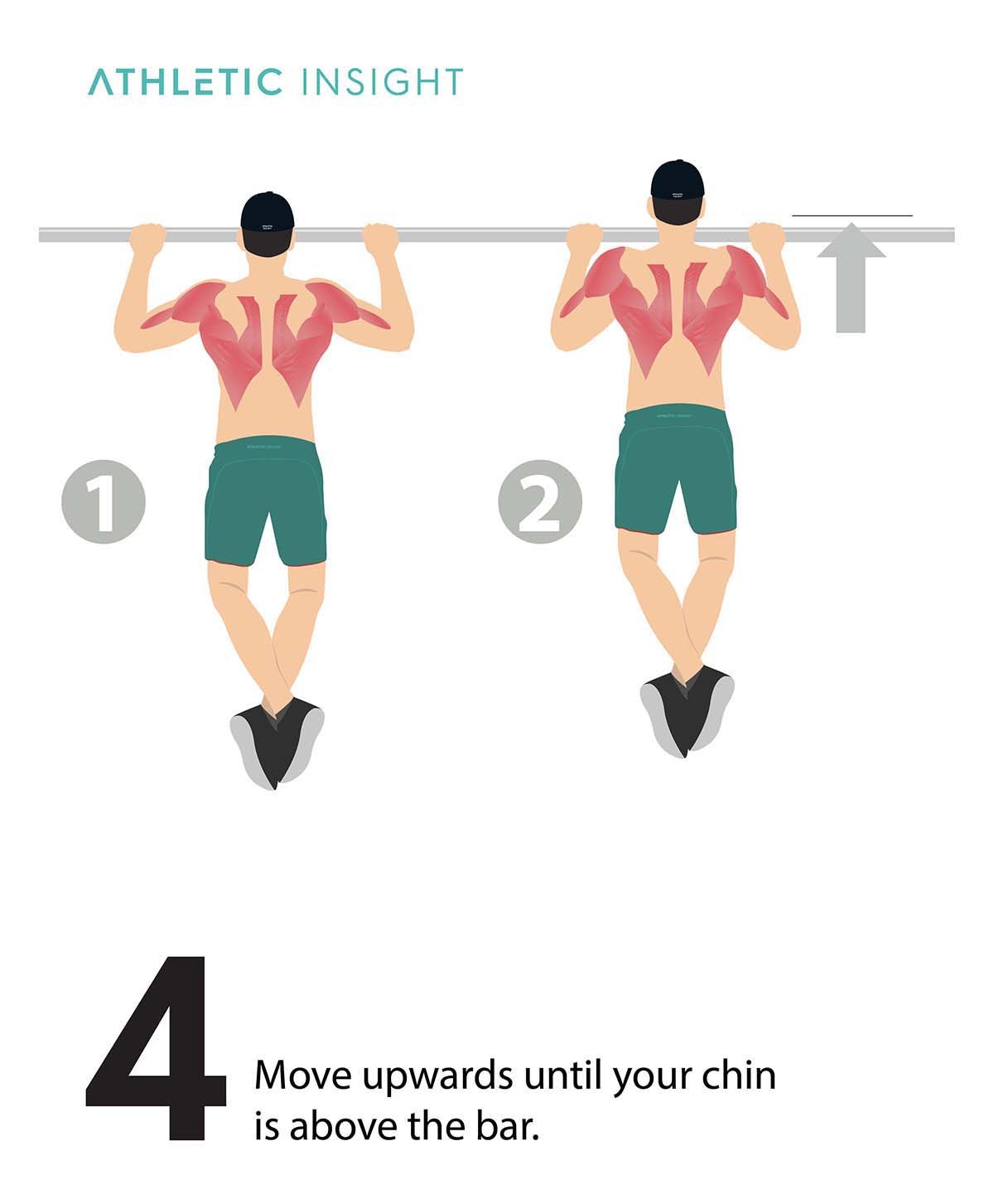
5. Move back downwards until your arms are fully extended again
As you lower your body from the top of a pull-up, you should maintain your form. This portion of the pull-up should be a perfect reverse motion of step 4. At the bottom of the pull-up, the arms should again be fully extended.
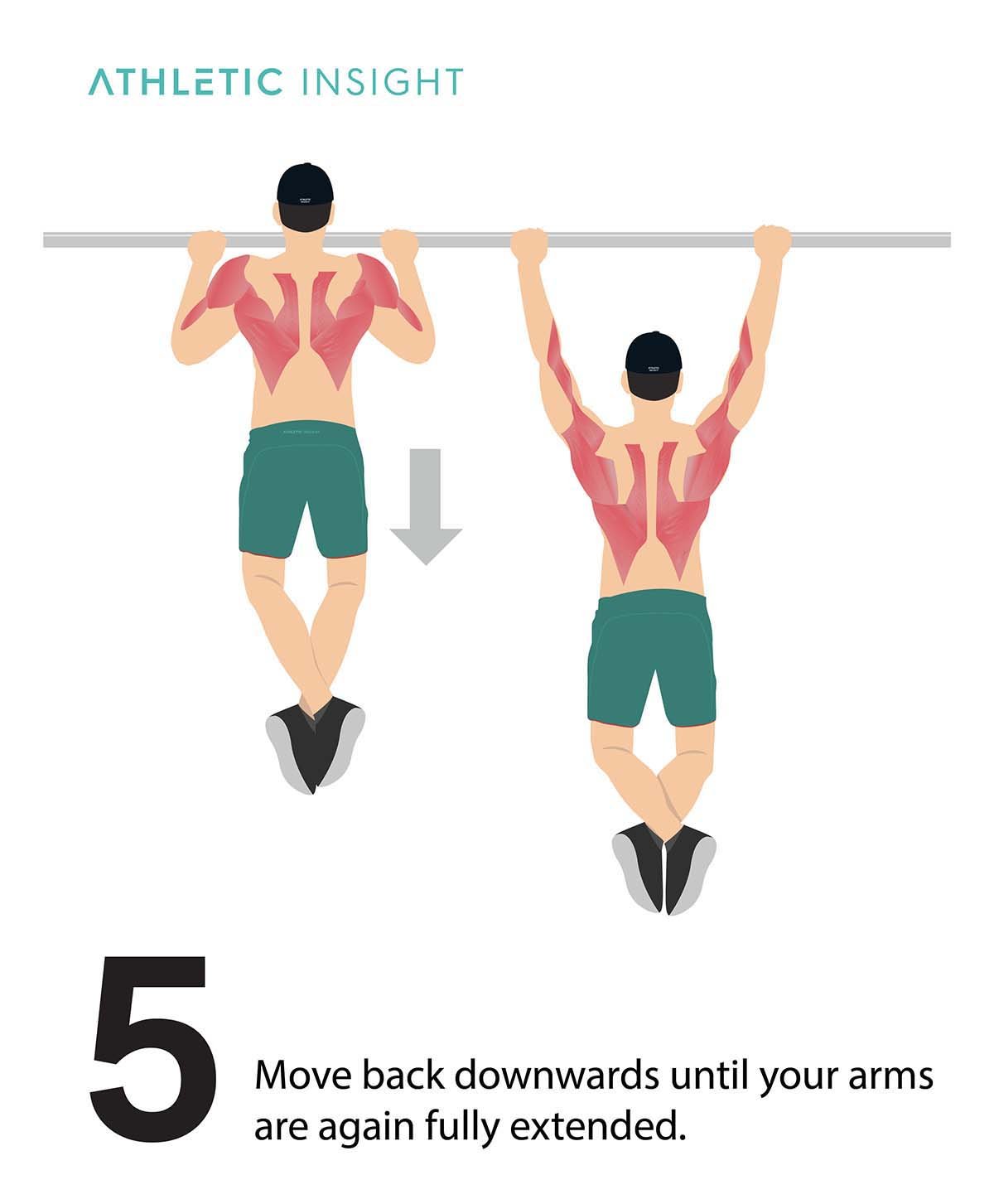
What Are the Pull-up Challenges?
Once you are able to perform a pull-up with perfect form, your new goal should be to increase the number of consecutive repetitions you can perform while maintaining this form. There are many methods of training, or challenges, available to aid in this endeavor.

The Every Minute On the Minute (EMOM) method and the German Volume Training (GVT) method are commonly used. Once you are able to attempt weighted pull-ups, testing your 1 rep max, or the highest amount of weight you are able to add for the performance of a single rep with good form, is both a great challenge for yourself and a practical way to calculate a good working load for weighted pull-ups.
Pull-Up and EMOM (Every Minute On the Minute)
This method is great for anyone, new and experienced, attempting to increase their pull-up volume. The idea is to perform a set number of pull-up repetitions once every minute for a set time frame. For example, you might set the time for 10 minutes and perform 2 pull-ups every minute. You can gradually add repetitions from here.
Typically, because of the high overall volume, you will want to set the number of repetitions per minute to about 30% of your maximum consecutive repetitions.
EMOM is a fantastic way to introduce progressive overload to your body. Over time, 2 pull-ups per minute can be increased to 3, then to 4, and so on. As always, it’s important to monitor form. EMOM is not about ego reps. Every rep should be performed with good form, and load increases should be gradual.
Pull-Up and GVT (German Volume Training)
GVT is an effective way to implement high-volume training into your routine. GVT is essentially a program consisting of 10 sets of 10 repetitions of a specific workload. For example, with pull-ups, you would simply perform 10 sets of 10 repetitions.
Of course, at a certain point, some bodyweight exercises will require extra stimuli with GVT, such as added weight or leverage changes. The advantage of GVT is the amount of volume that can be achieved. With 10 sets of 10 repetitions, you are performing 100 total repetitions with a certain workload. Even if you were performing pull-ups with an additional 5 pounds of weight, that would be 500 pounds worth of extra volume added to your body weight.
The problem with GVT is that the high volume makes it difficult to accommodate a significant workload and, therefore, can hamper progressive overload. GVT is still a great way to induce hypertrophy due to the high volume, particularly with weight training. If your goal is to increase pull-up endurance, you should use EMOM primarily, but GVT is a great way to gauge your progress and hit your body with significant volume.
Test the 1RM with Pull-Up
As you progress and venture into attempting weighted pull-ups, it’s important to gauge your potential workload. Knowing your 1 rep max (1RM) is part of understanding how much your body can safely accommodate. You can calculate your 1RM by using an online calculator.
A simple formula you can use is (x * 1.1307) + 0.6998, with x = your 4-6RM (the maximum weight you can perform an exercise with for 4-6 repetitions). For example, if you are able to perform 4-6 repetitions of pull-ups with 10 pounds added to your body weight, you would first multiply 10 by 1.1307, then add the result to 0.6998, which would give us a 1RM of about 12 pounds. After running these calculations, it’s a simple matter of testing the result.
Knowing your 1RM is vital for keeping track of progress, maintaining momentum, and knowing where you stand in terms of universal pull-up strength.
What Are the Pull-up Variations?
There are a number of pull-up variations. These variations may utilize different grip styles, varying grip widths, different equipment, or the addition of other movements. Here are a few examples:
1. Negative Pull-Ups
Negative pull-ups are simply pull-ups performed with an emphasis on the eccentric phase (the portion of the pull-up in which the body is lowered) of the movement. This variation allows those who are unable to perform standard pull-ups to build the strength necessary to be able to do so.
The subject will typically stand on an elevated platform of some kind, grab the bar with palms facing either direction at shoulder width, then leap up to where their chin is above the bar. At this point, they can maintain an isometric (muscles are contracted, but there is no motion) hold or start to slowly lower their body from this position. This slow descent should be the focus and will be the key to building strength primarily in the latissimus dorsi, posterior head of the deltoid, biceps muscles, and forearms.
The only additional equipment necessary here will be the elevated platform if the bar is too high to reach safely.
2. Kipping Pull-Ups
Kipping pull-ups are performed with controlled momentum. Unlike standard pull-ups, kipping pull-ups do not follow a straight line. The motion resembles a curve.
Kipping pull-ups start like a standard pull-up, with arms fully extended and palms facing away from the body at about shoulder-width. A pendulum motion will be initiated with the shoulders by arching the back, then hollowing the back (imagine creating a small hump with your mid-back). As you hollow the back, press forward with your arms still extended and lift your feet towards the bar. Repeat this motion until enough momentum is gained, then as you repeat the process of hollowing your back, start the pull-up motion until your chin is above the bar. Then push away from the bar to maintain this momentum and repeat the process.
The momentum involved in this pull-up variation allows for far more repetitions than can be performed with standard pull-ups. However, maintaining proper form can be difficult with kipping pull-ups, especially for beginners. It is also important to have a secured fixed bar, as the kipping motion can be dangerous otherwise.
3. Close-Grip Pull-Up
While the standard pull-up utilizes a grip width of about shoulder-width, close-grip pull-ups will utilize a narrow grip width, typically anywhere from just within shoulder width to both hands touching.
The form will remain the same, with full ROM and a tight core being a vital aspect of the movement. Palms can be facing away or towards the body, and some close-grip pull-up variations will even have either palm facing opposite directions. Full ROM with this variation can be more difficult, as your body will be positioned further from the bar, which considerably changes the exercise’s leverage.
The working muscles remain the same, but with a stronger emphasis on the latissimus dorsi, rhomboid muscles, and forearms and less on the scapular muscles. No additional equipment is necessary, making this variation very accessible.
4. Classic Pull-Up
The original pull-up that we are most familiar with, the classic pull-up, is one of the best exercises you can incorporate into your workout routine. Typically performed with palms facing away from the body at about shoulder-width, arms fully extended, and core fully stabilized, the standard pull-up follows a very linear motion.
The elbow and shoulder joints will flex and extend, but no other body joints should be in motion. It is important that the arms are fully extended at the start and end of the movement and fully flexed at the top of the pull-up, with the torso maintaining a neutral position at all times.
The classic pull-up is a powerhouse compound movement, providing stimulus to the latissimus dorsi, scapular muscles, rhomboids, trapezius, biceps, forearms, deltoids, and even the pectoralis major.
5. Tarzan Pull-Up
Tarzan pull-ups are very similar to close-grip pull-ups in that the hands are placed very close to each other on the bar. However, instead of both palms facing away or towards the body, in a Tarzan pull-up, both palms face opposite directions.
Stand under the bar and grip it with the palm facing towards the body. Then, place the other hand at the base of the hand already on the bar with the palm facing away from the body (similar to how a baseball bat would be gripped). As with any other pull-up variation, arms will start at full extension, and you must tighten your core.
From this bottom position, pull upwards towards one side of the bar until the bar touches the trapezius (between the shoulder and neck), maintaining a neutral spine.
Lower your body until the arms are fully extended again. At this point, the movement can be repeated, pulling to the same side of the bar. You can also pull towards the other side of the bar and alternate.
The Tarzan pull-up is unique in that depending on which hand is closer to the body and which side of the bar the pull-up is performed on, the stimulus provided will differ. Like the close-grip pull-up, the latissimus dorsi and rhomboids will play a significant role with the Tarzan pull-up.
One advantage of this variation is the use of the neutral grip position. It eases tension on the forearm muscles and is excellent for those who may experience wrist pain.
While full ROM is vital for all pull-up variations, with the Tarzan pull-up, partial ROM really defeats the purpose of the movement. So it is important to allow full extension of the arms at the bottom of the movement and to pull up until the bar touches the trapezius.
6. Side-to-Side Pull-Up (Typewriter/Archer Pull-Ups)
Side-to-side pull-ups, also known as typewriter or archer pull-ups depending on the execution of the movement, are an advanced pull-up variation. There are two ways to perform side-to-side pull-ups. In either case, the subject will start with hands on the bar, palms facing away from the body, and gripping the bar about an arm’s length apart. As with any pull-up variation, arms will start at full extension.
For the typewriter method, pull the body upwards, maintaining a neutral spine until the chin is above the bar. At this point, one arm will push away so that the body moves towards the other hand until the pushing arm is fully extended.
In this position, one arm should be completely straight and the other fully flexed, tucked next to the body. The flexed arm will then push away until the previous position is mirrored, with the arm that was previously extended now flexed and tucked next to the body and the other arm fully extended.
The body can then be returned to the central position on the bar and lowered with control until both arms are fully extended at the bottom.
Archer pull-ups will start with the same position as typewriter pull-ups. However, unlike other pull-up variations, one arm will remain completely extended as the other arm flexes to pull the body upwards.
At the top of this movement, the pulling arm will be fully flexed and tucked next to the body, with the other arm remaining at full extension, similar to the top position of typewriter pull-ups.
The body is then lowered in the same way, with one arm still fully extended. Repeat the movement, but the arm that was extended will now pull, and the other arm will remain extended.
Both typewriter and archer pull-ups require substantial core strength, grip strength, straight arm strength, and pulling power. The biggest mistake you can make with either variation of the side-to-side pull-up is failing to extend one arm fully.
With the typewriter variation, at the top of the movement, one arm should be able to push until you extend it fully. With the archer variation, one arm should remain extended throughout the entire movement. If you cannot perform the variations with this strict form, you are not yet strong enough to attempt them.
While side-to-side pull-ups utilize the same muscles as standard pull-ups, more core strength is necessary to perform these variations properly. The strength required from the latissimus dorsi and scapular muscles is also significantly higher than with a standard pull-up, especially for the archer variation.
You can use a standard pull-up bar, but it must be wide enough to accommodate a fully extended arm at the top of the movement, which means most doorway pull-up bars will not be useful here.
7. Pull-Up with Alternating Knee Twist
This variation of pull-ups adds a bit more core involvement to the pull-up exercise. The form will remain the same as with standard pull-ups but with an extra movement.
You can perform the knee twist with one or both legs, but in either case, the knees will be raised up towards the abdomen and then crossed in either direction.
If using one leg at a time, the right leg will cross to the left, and the left leg will cross to the right. If using both legs simultaneously, the legs will alternate crossing to the right and left.
This knee twist can be added at the bottom and/or the top of the pull-up. It is important that you do not use this twisting motion to gain momentum for the pull-up. This variation needs control, both on the way up and on the way down. The addition of a knee twist will obviously create more stimulus for the muscles in the abdomen, but if done correctly, this extra movement will also utilize the latissimus dorsi.
8. Pull-Up with Leg Raise
This pull-up variation is similar to the variation mentioned above with a knee twist. It will start just like a standard pull-up and then have the addition of a leg raise at the bottom and/or the top of the exercise.
The leg raise is very simple to perform. Simply raise the knees towards the chest. There are many ways to make this variation more challenging. The simplest way to do this is to raise the knees higher. The leg raise starts as an abdominal exercise, but the higher you are able to raise your knees, the more your latissimus dorsi muscles will become involved, making the leg raise an even more helpful exercise to utilize in conjunction with pull-ups.
Another great way to make the leg raise more challenging is to extend your knees. This change in leverage will increase the load your abdominal muscles and latissimus dorsi must handle in raising your legs upwards. The goal should be to touch your toes to the bar. The straight leg raise will utilize your latissimus dorsi considerably more than a bent leg raise.
You can even hold a leg raise position as you perform pull-ups. Leg raises will utilize your abdominal muscles and latissimus dorsi. A pull-up performed with legs raised, bent or straight, will further tax the abdominal muscles and is a fantastic way to strengthen the latissimus dorsi muscles.
The same point of advice that applies to pull-ups with knee twists applies here. You shouldn’t use the leg raise motion to gain momentum for the pull-up movement.
9. Walking Pull-Up
You may have seen calisthenics performances utilizing this pull-up trick. Advanced athletes perform pull-ups and make it seem as though they are walking on air. This movement requires tremendous stability and power in the core, latissimus dorsi, rhomboids, trapezius, scapular muscles, deltoid muscles, biceps, and forearms.
A pull-up typically consists of a concentric (when you pull up your body) and eccentric (when you lower your body) phase. Walking pull-ups will add an isometric (no motion) hold in between these phases.
The problematic aspect of this movement lies in the freedom of motion that exists during its performance. Those adept at walking pull-ups will move up, down, side to side, and diagonally and do so seemingly with no effort.
To truly create the illusion of one walking on air, an immense amount of control is required, calling for considerable core strength and power in the back muscles to create stability. No additional equipment is required, but as in side-to-side pull-ups, the bar needs to be wide enough to accommodate extended arms when at the top of the pull-up movement.
10. Weighted Pull-Up
Weighted pull-ups are essentially pull-ups with additional weight. This weight can be in a weighted vest, ankle weights, or most commonly, a weight belt. Whatever tool you use for this variation, the form remains the same as a standard pull-up.
Many will make the mistake of cheating on form in order to pull more weight. However, this is detrimental to actual progress and will only hurt your long-term success. As with standard pull-ups, weighted pull-ups should start and end with fully extended arms. Grip width is variable, but shoulder width is customary. The body should be pulled upwards, with the torso maintaining a neutral position at all times until the chin is above the bar.
As was mentioned before, you shouldn’t even attempt weighted pull-ups until you can perform 3 sets of 8-10 repetitions of standard pull-ups with good form. Once you add weight, utilize principles of progressive overload. Increase the amount of weight used gradually.
A weight belt is typically best for long-term weighted pull-up training, allowing for incremental weight addition. Otherwise, you can use a regular pull-up bar, but the added weight makes a doorway pull-up bar inadvisable.
11. Around the World
This pull-up variation is similar to side-to-side pull-ups. However, full extension of the arms at the top of the movement is not always necessary.
Grip the bar with palms facing away from the body and both hands about an arm’s length apart. Instead of pulling the body straight upwards, you will pull towards one side of the body until the chin is above the bar and one arm is tucked next to the body.
At this point, the tucked arm will push the body away to the other side until the other arm is now tucked next to the body. You can then lower your body until the arms are fully extended again, and you can repeat the movement on the same side of the alternate side.
Imagine a circular motion for this exercise, which lends itself to the name. Throughout this movement, you must maintain strict form (full extension of arms at the bottom, full flexion of one arm at the top, and neutral spine).
For this variation, you can increase the size of this circular movement as strength is improved. At its peak difficulty, one arm will remain fully extended when performing the pull portion of the exercise, maximizing the distance traveled “around the world.”
This variation is common in endurance challenges. It is taxing on the muscles involved, primarily the latissimus dorsi, scapular muscles, the posterior head of the deltoid, biceps, and forearms.
You can use a standard pull-up bar, but it needs to be wide enough to accommodate a fully extended arm as you advance in the exercise.
12. Towel Grip Pull-Up
You can perform the towel grip pull-up with an actual towel, a resistance band, or any object that you can hang over a bar and grip. Typically, the towel or other object of choice will be hung right over the bar so that both ends are on either side of the bar. You can grip these ends one in each hand or both in one, with the other on the bar.
When gripping the ends with both hands, this exercise will stimulate the same primary muscles as a close-grip pull-up, but grip strength is at the forefront, along with the latissimus dorsi and rhomboids. When only one hand grips the object, this variation becomes a great way to train for one-arm pull-ups.
The hanging object is more difficult to grip than the bar. Therefore, it leaves much of the pulling work to the side that has a hold on the bar. When training for one-arm pull-ups, you can progress the towel grip variation by moving your hand lower on the towel as you get stronger. This will gradually eliminate the work done by the pulling muscles of the side gripping the towel.
The difficulty of gripping the object makes it easy to compromise form, but full ROM and a neutral spine are still vital with this variation. A standard pull-up bar can be used here, including doorway bars, but the towel or other object needs to be strong enough not to tear or break from the strain of supporting your body weight. A good tip with towels is to fold them once before hanging over the bar to reinforce the fabric.
What Are the Necessary Equipment for Pull-up?
Pull-ups are such a versatile exercise because you can do them almost anywhere. A long, horizontal bar with plenty of clearance around it is ideal. However, you can also use pull-up bars that hang on doorways, squat rack pull-up bars, and even sturdy tree branches.
For beginners, having an elevated platform of some kind may be practical for setting up negative pull-ups, so jumping is unnecessary. Otherwise, the only piece of equipment you may want to have on hand is a weight belt or some other means of performing weighted pull-ups.
What Are the World Records for Pull-up?
There are a variety of world records available for pull-ups. Different organizations document these officially recorded events, such as Guinness World Records. If there are no officials on location, substantial video evidence is necessary.

One of the most important rules regarding pull-ups for records is full ROM, which means the full extension of the arms at the bottom and at least the chin above the bar at the top of the movement. Grip style must also remain consistent (in one attempt, you cannot perform pull-ups with palms facing away, then switch to palms facing the body).
Grip width is monitored as well since a wider grip will reduce the distance traveled with the exercise. No use of momentum is allowed unless the record pertains to kipping pull-ups. Dismounting the bar during an attempt is permitted, but there are different records for consecutive pull-ups in which one remains hanging on the bar with at least one hand at all times.
To break a record, you must first determine which specific record you will attempt to beat. Then, you must follow the rules for that particular record.
Here are a few examples of pull-up records that exist:
- Jan Kares performed 238 pull-ups in 34 minutes without dismounting the bar on November 18, 2017.
- David Marchante performed the heaviest weighted pull-up of 230.49 pounds on October 13, 2016.
- Hong Zhongtao performed the most pull-ups in 1 minute of 74 on October 30, 2020.
Women Pull-Up Records
- Rupa Hulet, Aug 30, 2020 – Most pull-ups in 1 minute (34); Rupa Hulet performed 34 pull-ups in 1 minute, setting a world record. The event was self-recorded and documented by Guinness World Records.
- Eva Clarke, Mar 10, 2016 – Most pull-ups in 1 hour (725); Eva Clarke performed 725 pull-ups in 1 hour as part of a charity event. The attempt was officially recorded and documented by Guinness World Records.
- Jessica Fresh, Nov 1, 2020 – Most pull-ups in 12 hours (2,775); Jessica Fresh performed 2,775 pull-ups in 12 hours in an attempt to perform 3,000 pull-ups in the same timeframe. This event was self-recorded and documented by Guinness World Records.
- Eva Clarke, Mar 10, 2016 – Most pull-ups in 24 hours (3,737); Eva Clarke performed 3,737 pull-ups in 24 hours as part of a charity event. The attempt was officially recorded and documented by Guinness World Records.
Men Pull-Up Records
- Hong Zhongtao, Oct 30, 2020 – Most pull-ups in 1 minute (74); Hong Zhongtao performed 74 pull-ups in 1 minute, setting the world record for males. The event was self-recorded and documented by Guinness World Records.
- Jan Kares, Nov 10, 2018 – Most pull-ups in 1 hour (1,124); Jan Kares performed 1,124 pull-ups in 1 hour, with records held previously in the 6, 12, and 24 hour time period records. The event was self-recorded and documented by Guinness World Records.
- Andrew Shapiro, May 14, 2016 – Most pull-ups in 12 hours (5,742); Andrew Shapiro performed 5,742 pull-ups in 12 hours for a charity event, which also set records for the 6 and 24-hour time period records (records that have since been beaten). The event was self-recorded and documented by Guinness World Records.
- Brandon Tucker, Oct 26, 2019 – Most pull-ups in 24 hours (7,715); Brandon Tucker performed 7,715 pull-ups in 24 hours, beating several previous records for the same timeframe. The event was self-recorded and documented by Guinness World Records.
What Is the Origin of Pull-up?
While the actual origin of the pull-up exercise is difficult to determine, we know that people used it as a form of physical training in ancient Egypt and Greece. However, it was popularized as a component of physical fitness, most notably in the late 18th and early 19th centuries.
It seems that even early on, the form for pull-ups that we know today was very much the standard. The body was kept in a straight line or neutral position and pulled upwards by the arms.
What has changed, however, is the way we implement the pull-up into fitness lifestyles. While it served as more of a functional exercise in its early days, over time, the pull-up has become an integral part of aesthetic fitness as well. This transition has given rise to different types of pull-ups.
Some of these newer variations are beneficial and serve to provide more or different stimuli to the body. However, many have taken excessive liberties with the exercise, and they often sacrifice good form in the name of pride. It is crucial that modern-day athletes, casual and professional, adhere to the form that has always been integral to maximizing the benefits gained from pull-ups.
Who Named the Pull-Up?
The exact origin of the pull-up is unknown. However, it is believed that the term “pull-up” was first used in the early to mid-1800s. Dr. George Barker Windship is notable for having used the term with relation to fitness.
Which Muscles Can Be Affected More From Pull-up?
The muscles that the pull-up affects most are the latissimus dorsi, the deltoid, the scapular muscles, the rhomboids, the biceps, the forearm muscles, the trapezius, and the pectoralis and abdominal muscles.
- The latissimus dorsi is involved in all movements that extend (pull) and externally rotate the shoulder joint. This muscle plays a primary role in both functional and aesthetic fitness.
- The deltoid is better known as the shoulder muscle because it is at the shoulder joint. Its three heads are involved in every movement of the shoulder joint. When it comes to pull-ups, the posterior head of the deltoid is primarily utilized for the extension of the shoulder joint (pulling motion) and external rotation during the movement. The anterior deltoid contributes to the internal rotation of the shoulder joint, which is used minimally during the pull-up exercise. Overall, the deltoid is a key player in pulling power and stability.
- The scapula, more commonly known as the shoulder blade, contains a number of muscles involved in the extension, flexion, rotation, and stability of the shoulder joint. These muscles work in conjunction with the latissimus dorsi, deltoid, and rhomboids to create the primary pulling motion of the pull-up exercise.
- The rhomboids, major and minor, are located below the trapezius and adjacent to the scapula. This set of muscles works to secure the scapula and retract it. The rhomboids will primarily come into play at the top of the pull-up movement when the scapula is fully retracted to pull the body as close to the bar as possible. This makes full ROM in a pull-up that much more significant, as this will determine whether you use certain muscle groups or not.
- The biceps is attached to the shoulder and elbow joints, making them multi-joint muscles. The biceps are primarily utilized in external forearm rotation and elbow joint flexion. Where the latissimus dorsi is the primary player in shoulder joint extension, the biceps are the primary muscle contributing to elbow joint flexion; both movements are heavily involved in the pull-up exercise. For this reason, the pull-up is a great way to strengthen the latissimus dorsi and biceps and optimize synergy between them.
- The forearm contains several muscles involved in elbow joint flexion and rotation, wrist joint flexion, extension and rotation, and movement of the fingers, which means grip strength is dependent on these muscles. While the forearm is utilized in the elbow flexion in the pull-up, it primarily acts as a base from which this movement can originate.
- The trapezius is located at the base of the neck and is responsible for scapular elevation (shrugging shoulders). It’s also involved in scapular retraction and shoulder joint internal rotation. Like the rhomboids, the trapezius primarily comes into play towards the top of the pull-up movement.
- The pectoralis is better known as the chest. Many relegate the pectoralis muscles exclusively to pushing movements. Still, these muscles also contribute to the internal rotation of the shoulder joint and the anterior head of the deltoid and scapular muscles. In relation to the latissimus dorsi, the pectoralis acts as an antagonist muscle, which refers to a muscle that opposes another muscle’s movement.
- Abdominal muscles – The muscles in the abdomen are responsible for flexion, rotation, and stabilization of the torso. Many think of the abdominal muscles mostly in relation to crunches and sit-ups, but their primary function is stabilization and posture. In the pull-up movement, the abdominal muscles are used to maintain a neutral spine, which contributes to the safety and efficiency of the exercise.
What Are the Back Muscle Exercises With Pull-up?
The pull-up is an effective exercise that stimulates size and strength growth in your arm and back muscles and promotes core strength and stability. It can and should be a component of any back workout routine.
Here are two examples, one with the pull-up as a primary exercise and the other with the pull-up as an accessory exercise. Both are great ways to incorporate the pull-up for back growth.
Workout 1
- Pull-ups – 3×5-7
- Leg raises – 3×5-8
- Dumbbell pull-overs – 3×5-7
- Reverse cable fly – 3×8-10
- Biceps curls – 3×5-7
The pull-ups will be weighted, if possible. Otherwise, use a pull-up variation with good form for no more than 3 sets of 5-7 repetitions. For the leg raises, the key is to raise the legs, bent or straight, as high as possible in order to force latissimus dorsi involvement.
Workout 2
- Barbell rows – 3×5-7
- Cable lat pull-downs – 3×8-10
- Close-grip cable row – 3×8-10
- Reverse cable fly – 3×8-10
- Pull-ups – 3 sets to failure
The previous workout serves as more of a functional program for strengthening the pull-up movement, whereas this workout is a more typical bodybuilding split with plenty of volumes. Both are conducive to strengthening the back muscles and stimulating hypertrophy.
What Are the Leg Muscle Exercises With Pull-up?
Pull-ups utilize almost every muscle in the upper body. But it can be used in conjunction with lower body exercises, as well. Compound lifts like the squat and deadlift require the synergy of both the legs and the back muscles. In other words, back exercises like pull-ups complement leg exercises very well. Here is an example of a leg workout that incorporates pull-ups:
Strength training pull split
- Deadlift – 3×5
- Weighted pull-up – 3×5-7
- Dumbbell lunges – 3×7-10
- Leg raises – 3×5-7
- Hamstring curls – 3×7-10
While the deadlift is technically not a “pulling” exercise, it utilizes many muscles typically responsible for pulling movements, such as the muscles in the hamstrings and the back muscles. For this reason, it fits very well into a pull exercise split in a workout routine.
The pull-up is a pulling exercise in the purest sense and further emphasizes the stimulus provided by various leg exercises for the latissimus dorsi and trapezius muscles.
What Is the Effectiveness of the Pull-up for Muscle Growth Compared to Squat?
Pull-ups are a key component of modern functional training. Many believe function, strength, and aesthetics cannot align, but compound movements like pull-ups and squats are evidence of the contrary. Not only are pull-ups a fantastic way to improve both pulling strength and endurance but they also contribute to the upper body appearance many strive for.
As a compound movement, several joints are in movement at once when executing a pull-up, and a number of muscle groups work together to complete the movement. This makes the pull-up extremely efficient, as it stimulates growth in multiple muscles at once.
In addition, compound movements like the pull-up and squat improve the body’s ability to move as one unit. At the same time, the squat is a superior exercise simply because it utilizes almost the entire body and because of its functional relevance, the pull-up is not far behind. Both movements can and should be a part of any workout routine, whether the athlete has never touched iron before or is a seasoned veteran.
Do pull-ups affect hormones?
The simple answer is yes; pull-ups affect hormones. A published study indicates that in all participants, but especially those younger (this particular test included only male participants), there was an increase in growth hormone and testosterone when the subjects performed total body exercise.
This test did not involve pull-ups specifically but did test responses to a number of exercises, including compound exercises like pull-ups. However, there is a clear correlation between positive hormone activity and the performance of compound exercises.
While exercise, in general, will lead to an increase in growth hormone and testosterone, both integral to recovery from exercise and to growth, compound exercises force a stronger reaction from the body and result in considerably higher concentrations of these hormones.
To optimize this effect, it is best to make compound movements such as pull-ups and squats central to your routine, with isolation movements serving as accessory movements.
Do pull-ups Increase testosterone?
Yes, pull-ups increase testosterone levels. Studies show that all exercise has a positive effect on testosterone levels. However, the effect that compound movements like pull-ups have on hormones is much greater than with others.
Not only do pull-ups trigger a higher physiological response from the utilization of multiple joints and muscles, they also prompt a stronger neurological response from the greater levels of positive stress placed on the body.
Do pull-ups affect mood?
Pull-ups affect mood positively for several reasons. From a biological standpoint, exercise in general promotes the release of hormones that influence our positive moods, triggering happiness and excitement. As a compound exercise, pull-ups hold a greater level of influence in this area as well.
Another point of consideration related to mood is goal attainment. Few fitness goals that are attainable so early on in your journey will bring as much excitement as being able to perform your first pull-up. And improving upon this initial achievement will allow you to attain goals that you never thought possible.
Pull-ups improve your body’s ability to move and perform like a well-oiled machine. Being able to function physically at a higher level in itself is a reason to be happy, but pull-ups aren’t just for function. This exercise will also help you to feel and look better.
Is the pull-up practiced within Crossfit?
Yes, pull-ups are part of the exercises within the Crossfit community. In competition and for Workout Of the Day (WOD) programs that Crossfit is known for, kipping pull-ups are typically practiced. Athletes are able to perform more repetitions due to the aid from momentum and this is conducive to Crossfit ideology and methods.
Is Pull-Up a military movement?
Yes, the pull-up is used in the military. While the implementation of pull-ups in military induction and training varies depending on the country and military division, this military exercise is a staple of many training regimens. For example, the United States Marine Corp requires men to be able to perform between 18 to 23 pull-ups before consideration.
Are pull-ups dangerous?
No, generally speaking, pull-ups are not dangerous. In fact, as long as you maintain a proper form and set up the equipment properly, the pull-up is one of the safest exercises you can perform.
On the other hand, if the form is lacking or you do not install the equipment correctly, you can develop imbalances or create falling hazards. Learn to do pull-ups properly, and you will have one of the safest and most accessible exercises available to incorporate into your routine.
Is the pull-up a push or pull exercise?
Pull-ups are a pull exercise, as the name implies. What constitutes a pull exercise? Well, with relation to the upper body, flexion of the elbow joint and/or extension of the shoulder joint are involved in what athletes will consider a pulling exercise. The pull-up utilizes both movements, and so, it’s a pull exercise in the purest sense.
While this is not always the case, pull exercises will also typically stimulate growth in the back muscles, in the posterior head of the deltoid, in the biceps, and in the forearms.
Are pull-ups essential?
While pull-ups are not essential, they are one of the best exercises you can implement in your routine. There are very few pull exercises that are as effective and as accessible as the pull-up. The only equipment required for performing pull-ups is a bar which can be installed almost anywhere, including doorways inside the home. For most people, there is little to no reason not to include pull-ups in a workout regimen.
Is the pull-up an Olympic lift?
The pull-up is not an Olympic lift. However, weightlifters can and should use the pull-up, including those involved in Olympic lifting.
Many Olympic lifts heavily rely on the muscles strengthened by pull-ups, such as the trapezius, latissimus dorsi, deltoid, scapular muscles, biceps, and forearms. In addition, pull-ups are a great way to maintain thoracic mobility, which is essential for Olympic lifters.
Is the pull-up a compound exercise?
Yes, the pull-up is a compound exercise. Compound exercises utilize various muscles, whereas isolation exercises focus on a single muscle or muscle group. The pull-up involves almost every muscle in the upper body, making it one of the most comprehensive compound exercises.
What can replace pull-ups?
There are some exercises that you can implement in place of pull-ups. While few movements are as effective as the pull-up, bent-over rows and lat pulldowns will provide similar stimuli and are solid compound movements.
The bent-over row is still a shoulder joint extension movement and utilizes the latissimus dorsi primarily, but the rhomboids and trapezius will play more important roles here. The biceps are still present in the execution of the exercise, but its utilization is relatively minor. Pull-ups are still the king of pull exercises, but movements like the bent-over row can serve as replacements.
Is the pull-up a multi-joint exercise?
Yes, the pull-up is a multi-joint exercise. As the description implies, multi-joint exercises utilize multiple joints. Pull-ups are performed by flexing the elbow joint and extending the shoulder joint.
Especially when executed properly with full ROM, the pull-up provides sufficient stimulus to all of the muscles attached to these joints for an increase in strength and size. Regardless of which variation you use, the pull-up remains a multi-joint exercise.
What are some pull-up alternatives?
As mentioned before, you can implement bent-over rows and lat pulldowns in a workout routine in place of pull-ups. Barbell, dumbbell, cable pullovers, cable rows, and deadlifts are some other pull-up alternatives.
Every variation of rows will heavily stimulate growth in the latissimus dorsi, rhomboids, and trapezius, primarily. Pullovers are great for training straight-arm shoulder joint extension movements in the latissimus dorsi. The deadlift, of course, is another fantastic exercise that trains the “pulling” muscles of the lower body but also contributes to strength and size in the latissimus dorsi, trapezius, and rhomboids.
These exercises work best in conjunction with pull-ups, but if for whatever reason implementing pull-ups in your routine is not possible, they will serve as suitable alternatives.

